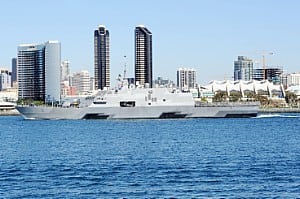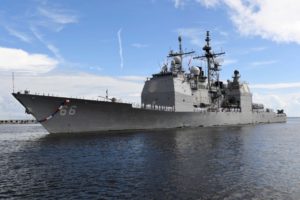The Navy’s fiscal year 2023 budget request is seeking to buy nine more ships in 2023, but also wants to retire 24 other ships in an act that would reduce the overall ship count to 280 battle force vessels within five years.
In the FY ‘23 request, the Navy is asking for $24.8 billion in shipbuilding to buy two Virginia-class attack submarines; two
Arleigh Burke-class destroyers; one Constellation-class frigate; one America-class amphibious assault ship; one Flight II San Antonio-class amphibious transport dock ship; one John Lewis-class replenishment oiler; and one Navajo-class towing, salvage, and rescue ship.
The Navy is also looking to fund the service life extension program for two LCAC landing craft and to buy two more new Textron [TXT] Ship-to-Shore Connector (SSC) LCAC-100 class landing craft. In the FY ‘22 budget, Congress boosted the Navy’s SSCs request from two to five.
Despite these numbers, the Navy is also looking to retire a whopping 24 total ships to save $3.6 billion over the next five years. This includes nine Lockheed Martin [LMT] Freedom-variant Littoral Combat Ships (LCSs), five Ticonderoga-class cruisers, four Whidbey Island/Harpers Ferry-class dock landing ships, two submarines, two oilers, and two Expeditionary Transfer Dock ships (ESD).
Of the 24 retirements requested, 16 require a service life waiver for the class. While four of the five cruisers are at the end of their service lives, the Navy is asking to retire one early.
According to Navy budget documents, the service plans to procure two destroyers and two attack submarines annually and alternate between one and two frigates per year over the five-year Future Years Defense Program (FYDP) outlook. However, given the 24 planned retirements and pressure from the Columbia-class ballistic missile submarines, the Navy foresees a lowering total ship count over the next five years.
The documents show the total ship count lowering from 298 today to 297 ships in FY ‘22, 285 in FY ‘23, 287 in FY ‘24-25, 284 in FY ‘26, and down to 280 ships in FY ‘27.

Within the LCS retirements, “we’re getting rid of number three [USS Fort Worth], which is a test ship, and then we’ve got a mission set that is going away, which is the anti-submarine mission set. So as we move those away, we’re going to free ourselves” to be able to better maintain ships and move the funds to support other priorities, Meredith Berger, Performing the Duties of Under Secretary of the Navy, told reporters during a roundtable Monday before the budget was released.
Rear Adm. John Gumbleton, Deputy Assistant Secretary of the Navy for Budget, told reporters that under this request the Navy Department had real funding growth of five percent for the Navy and two percent for the Marine Corps.
“I would admit a lot more money than we thought we were going to get at the beginning of this process,” he said.
However, Gumbleton said the Navy is prioritizing funds for its requirements. He noted that 56 percent of the Navy’s shipbuilding budget, devoted to nuclear-powered vessels, only involves building two new attack submarines. That “really speaks to the pressurization that Columbia-class is driving for the [Department of the Navy].”
This means of the $27.9 billion in shipbuilding funds, 21 percent goes toward incrementally funding the new Columbia-class ballistic missile submarine (SSBN), nine percent for incremental funding of the Ford-class aircraft carriers, two percent for aircraft carrier refueling and complex overhaul costs, and 24 percent for the two Virginia-class attack submarines. The other 44 percent of the shipbuilding account covers 11 ships.
Gumbleton said the Ford and Columbia-class ships are a “huge pressure” that forces the Navy to balance many factors. The Navy consistently names the Columbia-class submarine as its number one funding priority, to recapitalize the sea leg of the nuclear weapons triad.
Given the pressure, he said the Navy only wants to buy ships to the extent they can deliver, maintain and sustain them along with the weapons, personnel, and fuel required.

“And then we looked at what we had in our inventory, and the cost to maintain some of those older ships, so that’s where you get to the LCS.”
Gumbleton said when accounting for the total lifetime costs of the nine LCSs, “the future savings are significant and regrettably we’ve eaten that sunk cost. But on the LCSs alone over the FYDP, the value I could retain to reinvest is significant.”
He also said the $3.6 billion in divestment savings “is not an insignificant number” given the Navy’s SSBN and other pressures.
“Then we say ‘ok we have to modernize too, where can we going to get that value to modernize?’ A piece of that was a choice of going after these…vessels that were very expensive to maintain and our cruisers at the end of their life. LCS is a regrettably younger ship, but the warfighting value, that was the tradeoff,” Gumbleton said.
Gumbleton underscored the decision to retire nine Freedom-variant LCSs was driven more by the Navy wanting to save costs by cutting ships planned to feature the failing anti-submarine warfare (ASW) mission package, rather than repair costs associated with fixing the combining gear. The ASW systems have “huge challenges, not going to work,” he said.
“If I were to be completely transparent, the drive train fix isn’t an exorbitant amount of money, but when you target your savings at one variant, there’s savings programmatically instead of having to sustain two different lines. So, collectively, ASW and drivetrain led us to this,” Gumbleton said.
The Freedom-variant LCS has been plagued by propulsion issues for over a year. Last year, the Navy stopped accepting new ships of that variant due to a material defect in the combining gear (Defense Daily, Jan. 22, 2021).
The ship’s engine style means it can use either gas turbine engines, independent diesel engines or both to reach higher speeds. The defect affects the ship’s ability to use both combined. Since the issue was detected, the LCSs are limited to 35 knots compared to their advertised maximum speed of 44 knots.
Earlier this year, the Navy said it was still negotiating the cost sharing scheme to fix the combining gear, with repair costs set to be split 50-50 between the Navy and Lockheed Martin (Defense Daily, Nov. 18, 2021).